|
"The baby-figure of the giant
mass
Of things to come."
Troilus and Cressida, Act I.
Sc. iii.
"The channelstane,
The bracing engine of a Scottish arm."
Davidson.
"Loud throughout the vale the
noise is heard
Of thumping rocks, and loud bravadoes' roar."
Davidson.
"Now mark the dread sound as
our columns move on,
So solemn, so awful, so martial's the tone,
The clouds resound afar, whilst the waters groan
Stable rock
Feels our shock
As if stern Mars in transport spoke
Such the thunder and crash of the curling-stone."
Canonmills "Curler's March,"
1792.
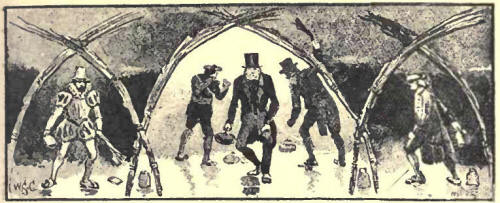
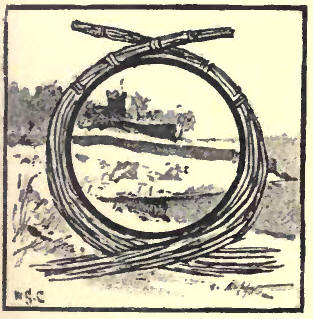 UR
enquiry into the origin and antiquity of curling brought its into contact
with a controversy about words. Our next chapter is a case of "sermons in
stones." Of crainpits, brooms, and other minor implements used in the early
game, there are few relics to be considered; but the different stages in the
development of curling are distinctly traced by the monumental stones that
have been brought under notice, especially since the formation UR
enquiry into the origin and antiquity of curling brought its into contact
with a controversy about words. Our next chapter is a case of "sermons in
stones." Of crainpits, brooms, and other minor implements used in the early
game, there are few relics to be considered; but the different stages in the
development of curling are distinctly traced by the monumental stones that
have been brought under notice, especially since the formation
of the Grand Club in 1818. Of these we have three types or varieties
distinctly marked, in the examination of which we are able to trace the
progress of the game. These types are:-
(1.) The KUTING-STONE, KUTTY-STANE, or PILTYCOCK.
(2.) The ROUGH BLOCK (with handle).
(3.) The POLISHED and CIRCULAR, STONE.
FIRST TYPE: THE KUTTING-STONE.—Curling,
when first practised, appears to have been a kind of quoiting on ice. The
stones had no handles, but merely a kind of hollow or niche for the finger
and thumb of the player, and they were evidently intended to be thrown, for
at least part of the course, the rink being shorter than it is now. III
handling these stones, it seems natural to infer that they were riot
delivered after being drawn straight back, but swept round from behind, and
sent toward their destination by a carving sweep. As might be supposed, they
were much smaller than stones of the handle type, minting front 5 or 6 to 20
or 25 Ibs. in weight. They would seem to have been picked up from the
channels of the rivers (Hence the term channel-stanes, though this may have
been given to them because of the channel or hove made for them in their
course on the ice). Mactaggart, in his amusing work, [The Scottish
Galloridian Encyclopedia (1824), 1). 130.] says that "when curling first
began it was played with flat-stones or loofies." [Loofie, a flat or plane
stone resembling the palm of the hand. Gall. Jamieson's Dictionary.] We have
seen that kuting and kluyten, the Dutch name for a game on ice, are not the
same word; but that curling, though now more allied to bowls or billiards,
did at first more nearly resemble the ancient galilie of quoits cannot
reasonably be denied. The Ettrick Shepherd, in his famous song, contrasts
the two gauzes thus:
I've played at quoiting in my day,
And maybe I may do 't again -
But still unto myself I'd say
This is no the channel-stane."
But it is certain that the word coiling, kuting,
or quoiting, was for a long time the word in common use to describe the
game, and in some districts it is still applied to it. Thus writes the
curling-poet of Chryston, W. Watson:-
The loch's aye the loch, whaur in cauld days o'
yore,
The lee-side was cheered by the quoitin-stane's roar,
Whaur aft our auld daddies wad off wi' their plaidies,
As they had been shown by their daddies afore."
And Grahame of "Sabbath" fame, at an earlier
date speaks of: "The
player as he stoops to lift his colt."
Andrew Crawfurd of Lochwinnoch, in a letter to
Cairnie in 1833, writes thus about a certain ice-hero:-
"Old Will M'Adam was a famous culler; he was
once in a bonspeil between the Glen and the Muirland conjoined against the
Brig-o'-Weir quoiters, with 14 a side. M'Adam was a very ugly man (like the
devil) in countenance. But he was an ingenious Man, up to the craft of
mounting of all manner of weaving work: he was a grand quoiter, he never
missed a shot; he was dignified by the Brig-o'-Weir folk with the
appellation of a warlock."—Cairnies essay, p. 93.
Sir Richard Brown, in his interesting
Memorabilia, calls curlers "the merry handlers of the quoit;" and at p. 103
he gives a letter from Principal Baird to, the Duddingston Club in 1822, in
which the Principal presents the club with "five stones, as specimens of the
original or earliest form of curling or coiting stones" which had been
recovered, one from a loch at Stirling, and four from the loch of Linlithgow.
"The stones, as will be seen, are from three to
four inches in thickness —of rather an oblong shape, and thinner towards the
point extremity. At the opposite and thickest extremity, there is on the
bottom (which has been artificially made quite smooth) a long thin hollow
cut out for admitting the fore part of the player's fingers: and on the
upper side of the stones there is a small hole for the point of the thumb.
From this form," the Principal goes on to remark, "it appears that the stone
has been coited or thrown by the hand to a short distance on the ice: if
thrown with force, and rightly floored, it must have been capable of being
propelled a very considerable length."
There are no dates on these stones, and Sir
Richard propounds a query in regard to their antiquity which it was
impossible at that time to answer. It was suggested by the following
discovery that had then just been made of a very ancient stone of the Second
type:- "Last week,
while the foundation of the old house of Loig, in Strathallan, was being dug
out, a curling-stone of a very different shape and texture from those now
generally in use in that district, was discovered. It is of an oblong form,
and had been neatly finished with the hammer. The initials `J. M.' and the
date 1611 are still distinctly legible, having been deeply though uncouthly
engraved. This discovery affords a curious and striking proof of the
antiquity of the name of curling."—Caledonian Mercury, 20th Dec. 1830.
Sir Richard's query was thus put:—"If a
curling-stone of an oblong form, `neatly finished with the hammer,' gives
the date 1611, what date will the pilty-cocks or kutingstones give?" For a
long time it was supposed that the oldest stone was that noticed in the
Annual of 1841, p. 11
"This last summer a curling-stone has been found in an old curling-pond near
Dunblane, bearing date 1551. It is 10 inches broad by 11 long and 5 thick,
and seems to have been taken from the bed of the river, and not to have been
dressed. There are two holes for the handle, as in the close-handled stones
still preferred in the district."
This Dunblane stone, it will be noticed, though
of very ancient date, is not of the primitive type, and it did not furnish
the answer to the query of Sir Richard Broun. It is only recently that a
kuting-stone, of date 100 years earlier than the Strathallan stone, has come
to light, and the Dunblane stone, so long supposed to be the most ancient,
has had to retire from the field. Not content with the custodialship of the
relics. of Sir William Wallace, Stirling, it would appear, now claims the
honour of guarding the most ancient relic of early curling.---
"In the Macfarlane Museum, Smith Institute, are
two old curling or rather kuting stones, one of which bears a date showing
it to be the most ancient stone in Scotland which has yet been discovered.
In shape this stone is nearly an oblong square, the sides being straight and
the top and bottom slightly rounded. The length is 9 inches, width 7½
inches, depth 4 5/8 inches, measurement round the middle 24 incises,
vertically 26 inches, and its weight 26 lbs. The hollow for the thumb is 1½
inches wide at the mouth, while the place for the fingers, which is
carefully carved, is 3½ inches long. On the upper side of the stone a small
space has been polished to receive the inscription, in Roman capitals, A
GIFT. while on the sole, which has been smoothed for the purpose, is the
following:- `ST Js B
STIRLING 1511.'

[It is right to note that the figures on this
stone are certainly not as old as they make out the stone to be. Dr Anderson
is of opinion that they have been cut out as late as the present century.
This does not, of course, disprove the antiquity of the stone, but tends to
cast a doubt upon it.]
"It can only be surmised that ST Js stands for `St James,' a popular saint
in Stirling, and B may be a contraction for ` Bridge' (or Brotherhood.'] It
is known that there was a St James' Hospital at the Bridge-end of Stirling
prior to the Reformation. The stone is made of blue whinstone, similar to
that of Stirling Rock, and having been a gift, it may be accepted as a fine
specimen of the curling-stones of the period.
"The other stone in the Smith Institute is of
the same material, but has the appearance of being older and more primitive,
and may have been originally a water-worn boulder taken from the bed of some
stream. Its shape is triangular, the sides and angles being rounded. It is
8¼ inches in length, and about the same in width, depth 4 inches,
circumference 22 inches, and weight 15 3/4Ibs. The thumb-hole and
finger-catch are roughly cut. A search through the records of the Museum has
failed to elicit any information regarding the history of these stones."
The above account of the remarkable relics
(Figs. 2 and 3) is given by Captain Macnair, in his interesting collection
of curling-lore [The Channel Stane. Fourth series, p. 66. The stones
themselves have, however, been specially sketched by our artist for this
work.] and is here reproduced by his permission. The present curator of the
Museum, Mr Sword, tells us that the stones are much prized, and carefully
preserved in a glass case, and that no further information regarding their
history has yet been furnished. It will be observed that one of the stones
referred to by Principal Baird was also found at Stirling, which evidently
bears the palms of antiquity. Thus, when Buchanan (who was a Stirlingite,
and is said to have written his History of Scotland at Stirling) was only a
boy of five, we have it proved that our national game was in existence at
his native place, though not worthy of notice afterwards by him or any other
historian of the time. We had the pleasure of seeing the Stirling stones in
the great Exhibition at Glasgow, 1888, where they were exhibited alongside
the no less venerable relics of our old archery and golf clubs in that
wonderful antiquarian temple—the Bishop's Palace and it is needless to say
that they were viewed with great interest by all curlers. At the same
Exhibition, on the stand of T. Thorburn, Leith, where the beautiful symmetry
and polish of the modern stones of this celebrated maker stood out in
striking contrast to their venerable forbears, the Marquis of Breadalbane
exhibited a pair of old stones [These stones were also exhibited at the
Jubilee Dinner of the R.C.C.C., Nov. 28, 1888.] (Figs. 4 and 5) which were
taken about thirty years ago out of Newton Loch, a mile below Tyndrum, while
it was being partially drained to make it safer as a curling-pond.
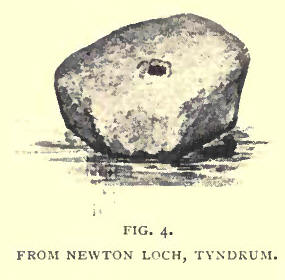 The
Marquis rightly regarded "the channel-stanes" as precious, insured them in
transit for £25; and they were laid aside with proporionate care at Glasgow
station, till it was almost too late for their entry at the Exhibition. A
porter was sent off at steam-speed with what he was taught to regard as a
valuable burden. He succeeded in reaching the place in time, and, with the
sweat streaming down his face, he watched the opening of the heavily-insured
box. Imagine his disgust when he saw what, in his eyes, were only two old
useless "blocks" turned out. The
Marquis rightly regarded "the channel-stanes" as precious, insured them in
transit for £25; and they were laid aside with proporionate care at Glasgow
station, till it was almost too late for their entry at the Exhibition. A
porter was sent off at steam-speed with what he was taught to regard as a
valuable burden. He succeeded in reaching the place in time, and, with the
sweat streaming down his face, he watched the opening of the heavily-insured
box. Imagine his disgust when he saw what, in his eyes, were only two old
useless "blocks" turned out.
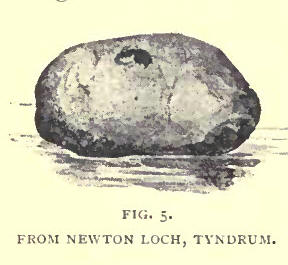 It
was too much for the poor fellow, and, in wrath, he thereupon uttered words
such as railway porters in our country are unfortunately too often heard to
utter, with less excuse. The stones which have so much to answer for are, no
doubt, very old; but as they are without date, we are left to conjecture
regarding them. Though they are about the weight of the early kuting-stones,
yet, as the holes in them are evidently not for the insertion of fingers or
thumbs, but for handles, they probably belong to a later period than the
Stirling stones. This is borne out by the fact that, along with them were
other stones, with iron handles almost rusted away, which have since been
lost sight of. This much is, however, proved by these interesting relies
that curling was once enjoyed in certain districts from which it has quite
disappeared. When the Breadalbane, Strathfillan, and Glenfalloch Club was
instituted in 1858, the people, we are told, were astonished to see the new
game; and an old lady, who died about six years ago, aged over 100 years,
had never seen or heard of such a game. An interesting point in connection
with this, as pointed out by Mr R. Macnaughton, Comrie, is that nearly as
far back as the middle of last century the game must have been played in
some parts of the Highlands, though there are some who think that it had not
at that time got beyond the Lowlands. It
was too much for the poor fellow, and, in wrath, he thereupon uttered words
such as railway porters in our country are unfortunately too often heard to
utter, with less excuse. The stones which have so much to answer for are, no
doubt, very old; but as they are without date, we are left to conjecture
regarding them. Though they are about the weight of the early kuting-stones,
yet, as the holes in them are evidently not for the insertion of fingers or
thumbs, but for handles, they probably belong to a later period than the
Stirling stones. This is borne out by the fact that, along with them were
other stones, with iron handles almost rusted away, which have since been
lost sight of. This much is, however, proved by these interesting relies
that curling was once enjoyed in certain districts from which it has quite
disappeared. When the Breadalbane, Strathfillan, and Glenfalloch Club was
instituted in 1858, the people, we are told, were astonished to see the new
game; and an old lady, who died about six years ago, aged over 100 years,
had never seen or heard of such a game. An interesting point in connection
with this, as pointed out by Mr R. Macnaughton, Comrie, is that nearly as
far back as the middle of last century the game must have been played in
some parts of the Highlands, though there are some who think that it had not
at that time got beyond the Lowlands.
At Linlithgow we seem to have evidence of an
unbroken connection between the ancient and the modern game. From the same
loch that now resounds with the "roar" of many a keen battle, and which Lees
has immortalised by his famous painting of the Grand Match of 1848, several
samples of the old finger or kuting-stone have been recovered. Some of
these, as we have seen, were given by Principal Baird to the Duddingston
Club in 1822, but of their present existence we have no intelligence. Mr W.
H. Henderson informs us that about twenty-five years ago a kuting-stone was
sent by him from Linlithgow to the Antiquarian Museum, Edinburgh. From the
description furnished by him, this stone must have been a good specimen of
the earliest type; but the Linlithgow relics seem to be unfortunate in their
destiny, for, after diligent enquiry, we have been unable to find any trace
of this stone. In the Museum there are, however, two specimens of the
earliest type of stone. One of these is the smallest we have seen, and is
much like an ordinary paving-stone. It was found embedded in the wall of an
old house in the High Street, Edinburgh, which was being demolished some
years ago, and brought by a workman to the Museum. Dr Anderson tells us that
he was at first inclined to regard it simply as a disused cobbler's lapstone,
but the marks for finger and thumb led him to suppose that it was a kuting-stone,
and there is little doubt that he is right in his supposition. That such a
stone should have been found in such a place is very remarkable, and may
suggest to Edinburgh curlers a claim of antiquity for the game on the Nor'
Loch that they have not as yet put forward.
Of the antiquity of curling in the Galloway
district we have several proofs in the form of loofie-stones, as they are
called by Mactaggart. The late Rev. G. Murray of Balnaclellan had a good
specimen among his collection of curling curiosities—"flat and wedge-shaped,
with places for the fingers on one side and for the thumb on the other." The
stone is now to be seen at his sister's house, Meadowbank, New-Galloway. A
similar stone is the property of a merchant there—P. Mackay. Two of these
ancient stones are also to be found in the Museum at Kirkcudbright, of which
Mr M`Kie is curator. They were found in Loch Fergus.
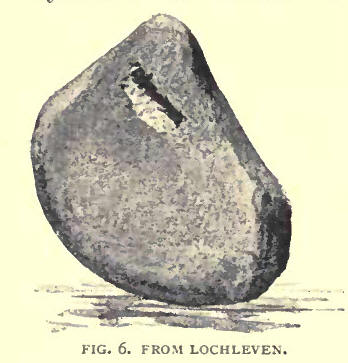 The
Doune Club have in their possession a good specimen of the Kuting-stone. It
was found some years ago in digging up the foundation of an old house in
Doune, which stood on a feu dating from 1664. It is a flattish, smooth
whinstone nearly circular, a little rounded on the top with flat bottom. It
is about 8½ inches in diameter, and weighs 14½lbs. The upper edges are a,
little clipped to give it proper shape, otherwise it has its natural smooth
surface. It has no handle, but has a hollow for the thumb, and a catch
underneath for the fingers. The
Doune Club have in their possession a good specimen of the Kuting-stone. It
was found some years ago in digging up the foundation of an old house in
Doune, which stood on a feu dating from 1664. It is a flattish, smooth
whinstone nearly circular, a little rounded on the top with flat bottom. It
is about 8½ inches in diameter, and weighs 14½lbs. The upper edges are a,
little clipped to give it proper shape, otherwise it has its natural smooth
surface. It has no handle, but has a hollow for the thumb, and a catch
underneath for the fingers.
Lochleven, like Linlithgow, seems to have an
unbroken record; and no doubt the game has had there a "local habitation" as
long as in any other part of Scotland. Wyntoun, the author of our first
national history--the Orygynall Chronykill of Scotland, was Prior of St
Serf's Inch, Loclileven, in the end of the fourteenth century; and it may
yet appear that he heard the boom of the channel-stane in the silence of the
monastery, but he makes no complaint about it, and most likely it was not
such a roaring game at that time as to disturb the Prior at his "Chronvkill."
That it was played on Lochleven from time immemorial is, however, abundantly
evident. Alongside of the small High Street stone there is a larger-sized
specimen of the Kuting-stone (Fig. 6) lent to the Antiquarian Museum by D.
Marshall, F.S.A., to whom it had been gifted by L Wylie, shoemaker, Kinross.
It was got out of Lochleven about fifty years ago, and for the most of that
period dial duty, like its neighbour, as a cobbler's lapstone. This Kinross
stone is of whin, flat in appearance and triangular in shape.
"In its general contour," says Mr Burns Begg,
"it may be said to resemble a small but thick Belfast ham, with the
shack-bone somewhat shortened. It never has been graced with a handle of any
kind, but it has on its lower side or sole an oblong hollow hewn out for the
accommodation of the fingers of the player, while on the upper side there is
a corresponding hollow for the thumb. The stone shows no trace of ever
having been polished artificially, but has been worn smooth by the action of
the water in the channel out of which it was taken."
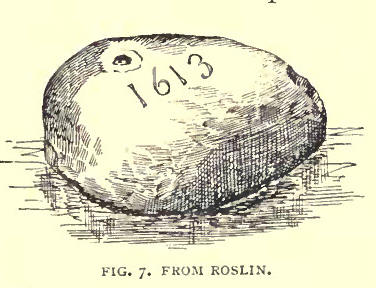 It
is stated in a Montreal paper (V Annual 1885-6.) that the Club there has in
its possession, among other historical relies, an ancient Kuting-stone found
at Roslin in 1826, and dated 1613, which was presented to them by the late
Dr Sidey. If the drawing which accompanies the statement is correct there
must be some mistake, or the Dr must have played a cruel joke upon his
Transatlantic "brithers," or the Annual of 1843 must have given a false
drawing; for, while this latter is reproduced here (Feb. 7), the Montreal
drawing is that of an ordinary handled block of the second type, in shape
like the Jubilee stone. A very good sample of the Kuting-stone, dated 1611,
is claimed by Torphican, where it was found in 1840 built in a wall, and a
notice of which appeared in the Annual of 1843 by Mr Durham Weir. It is of
grey whin, and the notch for the finger is 4 inches in length by 1 3/4
inches in depth. The curling-stone of the Covenanter Guthrie (Fig. 8), still
preserved in Craufurdland Castle, is also a legitimate type of the early
stone, though it must have been in use after 1644, when Guthrie was ordained
Minister of Fenwick. It
is stated in a Montreal paper (V Annual 1885-6.) that the Club there has in
its possession, among other historical relies, an ancient Kuting-stone found
at Roslin in 1826, and dated 1613, which was presented to them by the late
Dr Sidey. If the drawing which accompanies the statement is correct there
must be some mistake, or the Dr must have played a cruel joke upon his
Transatlantic "brithers," or the Annual of 1843 must have given a false
drawing; for, while this latter is reproduced here (Feb. 7), the Montreal
drawing is that of an ordinary handled block of the second type, in shape
like the Jubilee stone. A very good sample of the Kuting-stone, dated 1611,
is claimed by Torphican, where it was found in 1840 built in a wall, and a
notice of which appeared in the Annual of 1843 by Mr Durham Weir. It is of
grey whin, and the notch for the finger is 4 inches in length by 1 3/4
inches in depth. The curling-stone of the Covenanter Guthrie (Fig. 8), still
preserved in Craufurdland Castle, is also a legitimate type of the early
stone, though it must have been in use after 1644, when Guthrie was ordained
Minister of Fenwick.
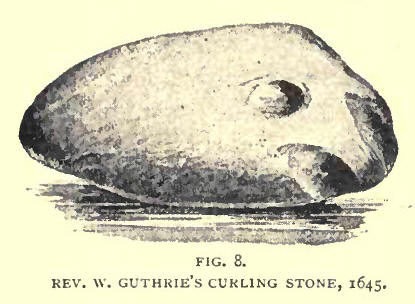 The
period in which this Kuting-stone, Kutty-stane, Piltycock or Loofie was in
use may therefore be put down as extending from the beginning of the
sixteenth to. the middle of the seventeenth century (1500 - 1650); though in
that time we have also proof of the second or handled type of stone. From
their construction it is evident that early curlers coited or skvyted the
stone along the ice; but as to the style of the primitive game little
further can be inferred. If further light is to be thrown on ancient curling
it is in this direction more than the etymological that we look for
information; and certainly, until specimens of these curious stones are
found in other countries, we are entitled to hold that the game is
indigenous to Scotland. No doubt other and earlier ones will be found, [For
an Account of the latest, see note p. 47 under Strathallan.] for the loofie
oracle has not spoken its last word at Stirling, Linlithgow or Lochleven;
but Curling antiquaries will do well on this point to remember Aiken Drum's
Lang Ladle, for Curling Clubs are keen to make it clear that the most
ancient relics are in their keeping, and some of them, after paying for the
Praetorium of an old Kitting-stone, may meet with an Edie Ochiltree to take
away their jov. [It is not a little curious to find that Quoiting and
Curling have resumed their early relationship among our Kinsmen "across the
pond." In the admirable Annual of the Grand National Club of America there
is published each year, alongside of the Rules of Curling and the bonspiels
of States' curlers, an account of a great contest held each year for a Quoit
medal with "Rules for Quoiting." In the days of the old Huddingston Society
the members also got up quoiting matches to bring them together in the
summer season.] The
period in which this Kuting-stone, Kutty-stane, Piltycock or Loofie was in
use may therefore be put down as extending from the beginning of the
sixteenth to. the middle of the seventeenth century (1500 - 1650); though in
that time we have also proof of the second or handled type of stone. From
their construction it is evident that early curlers coited or skvyted the
stone along the ice; but as to the style of the primitive game little
further can be inferred. If further light is to be thrown on ancient curling
it is in this direction more than the etymological that we look for
information; and certainly, until specimens of these curious stones are
found in other countries, we are entitled to hold that the game is
indigenous to Scotland. No doubt other and earlier ones will be found, [For
an Account of the latest, see note p. 47 under Strathallan.] for the loofie
oracle has not spoken its last word at Stirling, Linlithgow or Lochleven;
but Curling antiquaries will do well on this point to remember Aiken Drum's
Lang Ladle, for Curling Clubs are keen to make it clear that the most
ancient relics are in their keeping, and some of them, after paying for the
Praetorium of an old Kitting-stone, may meet with an Edie Ochiltree to take
away their jov. [It is not a little curious to find that Quoiting and
Curling have resumed their early relationship among our Kinsmen "across the
pond." In the admirable Annual of the Grand National Club of America there
is published each year, alongside of the Rules of Curling and the bonspiels
of States' curlers, an account of a great contest held each year for a Quoit
medal with "Rules for Quoiting." In the days of the old Huddingston Society
the members also got up quoiting matches to bring them together in the
summer season.] SECOND
TYPE: THE ROUGH BLOCK.—
Of the description of stone that marks the
second stage of ancient curling, there are innumerable specimens "of all
sorts and conditions." An ordinary human being when he gets a handle to his
name is thereby lifted into greater importance, and certainly acquires more
power if he makes a proper use of his title; so, when the leverage of a
handle was applied to the channel-stare it completely left behind the puny
piltycock, and developed enormously in bulk and weight. In its development,
however, it did not follow the curves of the beautiful. Another century and
a half must elapse before the rough block is lien into proper form, and the
curler realises that scientific skill is higher than brute force. The
corners have to be rubbed off, the angularities have to be rounded, the wild
diversity has to be reduced, and it takes time to do it. Yet, withal, this
bulging, unshapely, heterogeneous age of the curling-stone, when the
curler—ender the newly-gotten power of the handle—took the hinge from the
gate-post, soldered it into the big boulder, bent incumbent under the
weight, swung the block in air, and hurled it up the rink with giant
strength, is an interesting one. "All affectation of minute accuracy," some
wise writer says, "in cases where in the nature of things accuracy is
impossible, is always a suspicious feature in a historian." In dividing our
study of stones as we have done, we do not presume to draw a distinct
line--saying here the Handle type begins and there the no-handle type ends.
The Dunblane stone and the Tyndrum stone, while veritable loofies in other
respects, had evidently been played with handles in the period of our
handle-less type of stone. Sometimes, as we shall see, the handle was an
after-addition to an old stone that had been played without it; and it is
plain that handles were in use before the finger-and-thumb stone was
discarded. We find also among stones of the later period many as diminutive
as any of the Kutty-stanes, their weight being under 20 lbs., pigmies among
the giants. This granted, we can, however, mark off a second period of 150
years, from about the middle of the seventeenth century on toward the end of
the eighteenth, when the stone in common use was in some respects as unlike
the early Kuting-stone, as it is to its polished and aristocratic descendant
of modern times. In this period stones (and handles also) were of infinite
variety and shape. Sir Richard Broun (p. 42), in describing those in use at
Lochmaben, describes generally the stones of the period.
"They were of a wretched description enough.
Most of them being sea-stones of all shapes, sizes, and weights. Some were
three-cornered, like those equilateral cocked hats, which our divines wore
in a century that is past—others like dicks—others flat as a frying pan.
Their handles, which superseded holes for the fingers and thumb, were
equally clumsy and inelegant: being malconstructed resemblances of that
hooknecked biped, the goose."
Wretched as they may be, and useless for all
practical purposes in modern curling—as much behind our modern Ailsa. or
Crawfordjohn as the flint-lock of Marston Moor and Culloden is behind the
modern Martini-rifle; Yet nowadays, when the Zeitgeist of historical
research is at work everywhere, Curling Clubs vie with each other in
collecting from out-of-the-way corners these uncouth stones of other days.
Time was when little respect was shewn to them—when they had to do duty as
weights for weavers' looms and thick-ropes and cheese-presses, or lie
neglected among the rubbish at the back of the curling pond; but now they
are sought after, and, when found, readily elevated to places of honour.
Many, alas have met with the fate of "Whirlie," so pathetically described by
J. J., a member of the Penicuick Club in the Annual of 1847.
"Whirlie" was of oblong triangular shape, and
altogether a curling stone of nature's own making, being untouched with the
workman's hammer, except the hole in which the handle was inserted. It was a
jet black whin, and the sole, altogether a natural one, was very smooth,
which, with the dense and fine quality of the stone, made it a keen runner
even on dull soft ice. Tradition states that it was the favourite stone of
Sir John Clerk, one of the Commissioners of the Union, but nothing is
transmitted regarding its previous history. It was the first stone which the
writer of this ever played with, when but a very young lad about fifty-five
years ago; and we have never forgot the diversion which our youthful play
and this ancient stone afforded to both curlers and spectators. It being our
first attempt at curling, we were appointed to lead, which we happened to do
in such a manner that Whirlie was uniformly laid on or near the Tee; to
remove it from that position on which it had taken rest was no easy matter,
because, should the stole which was destined to remove it strike any one of
the angled corners, round went Whirlie, round and round, without ever
shifting from its position, while the stone which struck it went at right
angles across the rink. Stimulated with the success of our first attempt at
curling, we were early next day on the field of action with Whirlie in our
hand. But to our utter disappointment, poor fellow, a Curling Court was held
upon him, and he was unanimously condemned to perpetual banishment, or
rather to solitary confinement. This, however, we could not stand. We got
him mounted in a more modern and fashionable uniform, by rounding his more
acute angles, and in this capacity we introduced him as a stranger on his
ancient domain. A bad character and bad habits, however, have a mark put
upon them, and are not easily surmounted. The rogue, in spite of all our
endeavours, was still seen in his new shape and in his habits likewise, for
his roundabout way of going to work never forsook him, and again and again
has lie been banished from, and restored to the society of his fellows;
until at last we had the galling mortification to hear his final doom
decreed by the present Baronet, that this favourite stone of his illustrious
ancestor should be played with no more. Since then the Ice, and all the
curlers, except ourselves, who well knew him once, know him no more, and
perhaps for ever. But many are the lingering emotions of fond affection with
which we have sought after him; nor will we desist from the search until we
in our turn shall be consigned to oblivion. But should we have the good
fortune to find him, he shall have a `museum' for his abode, and be
henceforth preserved as an "Ancient Curling curiosity."
"Whirlie" is a type of inane in appearance and
in habits, and we are afraid in destiny also; but "the lingering emotion of
fond affection "that followed him to his unknown bourne now protects
hundreds of his contemporaries from such an unwished-for ending to their
curling career; and as the Royal Club, in its year of Jubilee, has decided
to form a collection of historical relics such as these, curlers will
by-and-bye have an opportunity of meeting face to face many of these brave
old warriors, and many that now lie outcast and neglected will, it is hoped,
be rescued from oblivion. It is not in the power of every club to secure
such specimens, but those that have them ought to be proud of them. From
returns furnished to us we give the names of some of the clubs that either
possess or can account for old curling-stones of the second period, and
statements regarding them, which will demonstrate forcibly what we have said
as to the variety in weight and appearance of these rude engines of ancient
curling warfare.
ABERDOUR.—Some stones, with fixed iron handles, are in the possession of the
Club, which weigh 83 lbs. each.
ALLOA—PRINCE OF WALES.—Two very ancient stones
were found when cleaning Ardoch pond about ten years ago. They are in the
hands of the President, Alexander Gall.
ALYTH.—The Secretary of this Club (J. Ferrier)
says: "The curlers in olden times took the stones as they got them from the
bed of the stream or the hillside, and all the workmanship bestowed on them
was the fixing of a bent Piece of iron into each as a handle. The forms of
the stones generally suggested the names of them. There were `Rockie,' 'The
Goose,' 'The Deuk,' &c., &c. In these clays curlers must have been powerful
men, for the stones were very heavy and none of the keenest. Instead of a
house, the curlers had only a small piece of ground fenced in with a rough
paling; in the form of a circle, and in the centre the stones were all
tumbled together in a heal). This looks as if the Druidical circle had still
been held in reverence among them."
ARDOCH.—Several stones were dug out of a pond on
the estate of Mr Drummond Moray when it was drained some years ago. One
(Fig. 9) is dated 1700, and is lettered A. W. H.
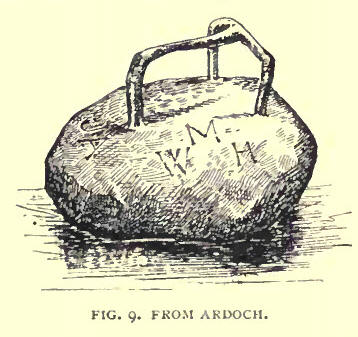 In
the interesting records of the Muthill Club, which go back to 1139, we find
the first name entered "The Rev. Mr William Hally, Minister, Muthill," and
this stone is supposed to have belonged to him, he being the first minister
at Muthill after the abolition of Episcopacy in 1690. In
the interesting records of the Muthill Club, which go back to 1139, we find
the first name entered "The Rev. Mr William Hally, Minister, Muthill," and
this stone is supposed to have belonged to him, he being the first minister
at Muthill after the abolition of Episcopacy in 1690.
This stone is unique in its way, having a three
- legged handle inserted into it. It has now become the property of the
Royal Club, having been gifted by J. M`Callum, Braco.
BLAIRGOWRIE and DELVINE Clubs both claim an
interest in the set of ancient stones here presented, these having, we are
informed, been formerly in the keeping of Blairgowrie, but presented or sold
to the Delvine Club, in whose custody they have been for many years. Fig.
10, "The Soo," weighs
79 lbs., and measures 161 x 11 inches. Fig. 11 is "The Baron," weighing 88
lbs., and measuring 14½ x 14 inches. Fig. 12 is called "The Ego," and weighs
115 lbs. It measures 17 x 12 inches. Fig. 13, "The Fluke," weighs 52 lbs.
and measures 12½ x 11 inches. Fig. 14, "Robbie Dow," weighs 34 lbs. and
measures 9 x 9 inches. This last and least was called after one of the Baron
Bailees, a, son of the parish minister of the time. They were all doubtless
taken in a natural state from the famous Ericht Channel, and they seem to
have done a good deal of work in
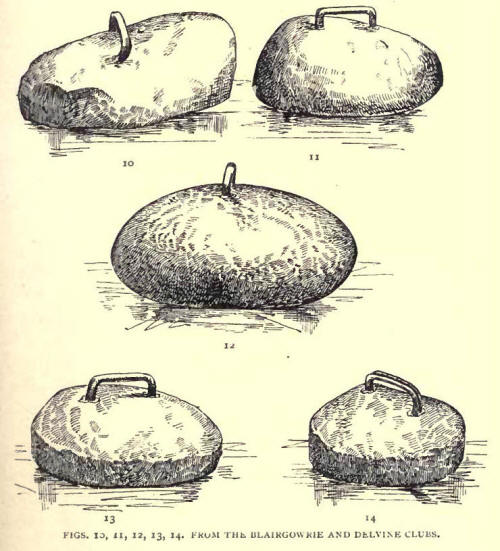
the hands of their strong masters. Their double
handles are noticeable. A metrical account of these and others is found in
Mr Bridle's Centenary Ode of the Blairgowrie Club:-
"In early years the implements were coarse,
Rude, heavy boulders did the duty then,
And each one had its title, as `The Horse'
One was 'The Cockit-hat' and one `The Hen'
`The Kirk,' `The Saddle,' President' and `Soo,'
`The Bannock,' 'Baron,' `Fluke,' and `Robbie Dow.' "
BRECHIN.—At Brechin Castle are old stones, found
in making present pond thirty years ago. They are river boulders in natural
shape, with a piece of iron inserted for handle.
CAMBUSNETHEN.—Specimens of rough stones with
wooden handles and one sole, in use from 1789 to beginning of present
century. CHIRNSIDE.-Six
pairs of very old stones are in possession of T. A. Calder, a. member of
this club. They were found in and in the bottom of Bonkyll Curling Pond
about forty years ago. They are hard unpolished whinstones with iron
handles. CLUNIE.—Several
of various shapes and weights: blocks of unhewn stone, with smith-made iron
handles. One is oval, measuring 46 inches in circumference, and weighing 9
lbs.; another, 90½ lbs.
 COUPER
ANGUS.—The following are the names and weights of a few of the more
celebrated stones in the possession of the club: — "Suwaroff," 84 lbs. COUPER
ANGUS.—The following are the names and weights of a few of the more
celebrated stones in the possession of the club: — "Suwaroff," 84 lbs.
"Cog," 80 lbs.; "Fluke," 72 lbs.; "Black Meg," 66 lbs.; "The Sant. Packet,"
116 lbs.
CRIEFF.---Several stones were found in 1881 at Lochlane, on Lord
Abercrombie's estate of Ferntower, near Crieff, and all or several of which
fell into the possession of Mr James Gray, builder, Bridge of Allan.
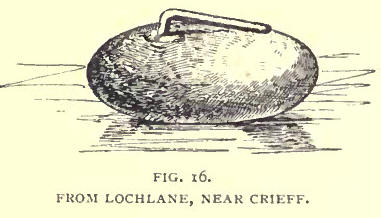 One
of these (Fig. 16) was given to Mr Henderson, Linlithgow, and presented by
him to the Royal Caledonian Club. The stones were found under the lower
steps of a spiral stair, the cavity having been built up with masonry. to be
seen in the Antiquarian incised in it. It was found in Brinkhill Pond,
Stirling, and belonged to the late Dr Mushet. One
of these (Fig. 16) was given to Mr Henderson, Linlithgow, and presented by
him to the Royal Caledonian Club. The stones were found under the lower
steps of a spiral stair, the cavity having been built up with masonry. to be
seen in the Antiquarian incised in it. It was found in Brinkhill Pond,
Stirling, and belonged to the late Dr Mushet.
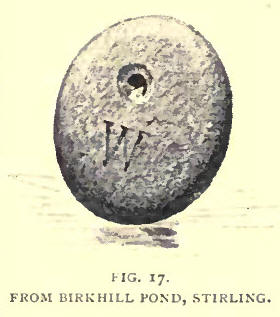 DALTON,
ST BRIDGETS.—An oblong oval stone is in possession of Robert Underwood,
Hightae. It is supposed to have been formerly in use on the southernmost of
the "mony lochs" of "Marjorie" (Lochmaben). DALTON,
ST BRIDGETS.—An oblong oval stone is in possession of Robert Underwood,
Hightae. It is supposed to have been formerly in use on the southernmost of
the "mony lochs" of "Marjorie" (Lochmaben).
DELVINE.—(see above under Blairgowrie).
DOUNE.—A stone, with the inscription I. Mc,
1732, is possessed by the club. It weighs about 5 0 lbs. This stone was
found some years ago when re-causewaying the close that leads to what is
known as The Clans' HaIl—a famous hostelry and favourite resort of curlers
in the latter half of last century. It is 102 inches long, and 91 inches
across at the broad end, and its contour is altogether quite unique, even
among stones of the boulder type. Another stone of similar shape, but
larger, used to be seen on the table at the annual feasts of the club, when
the late James Macfarlane, Woodside Cottage, was president. It belonged to
Archibald Greig, a noted and powerful curler of last century. This stone, we
believe, is now the property of William Forrester, at Campsie.
DUNBLANE.—There are two ancient stones here,
"The Provost," and "The Bailie," weighing about 60 lbs. each.
DUNFERMLINE.—A stone with DM:1696 carved on it.
It weighs 66 lbs., and resembles the half of an egg cut long ways. It has an
iron handle, run in with lead, is 38 inches in circumference Lengthways, and
30 inches measuring over top and round sole.
DUNS.—An animal expedition used to be made in
olden times to the Pease Burn, near Cockburnspath, to procure boulders, into
which rough iron handles were fastened. This custom existed till the
publication of the Rules of the Dudingston Society, when round stones came
gradually into use. The pride of this club, in the way of old specimens,
used to be "Rob Roy," a large whinstone, block, 18 inches in diameter, and
54 inches in circumference, without chisel or hammer mark. "Rob" was
purchased, in 1826, by David M`Watt, from a mason in Polwarth, for the sum
of 10s. 6d.; but he has been missing since 1856. "The Guse" and "Bluebeard"
have also gone astray; but "The Egg" is to the fore in the safe keeping of
Charles Watson.
EDINBURGH.—That the game of curling was in ancient times practised in and
around Edinburgh there is no doubt. We have already noticed the stone of the
early type to be seen in the Antiquarian Museum, and later on we refer to
stones that point back to the days of the old Canonmills Club. A specimen of
the second type of stone—the rough boulder—is illustrated in the Annals of
1841-42; and the following notice by Mr Palmer of Currie would seem to
suggest that curling was practised in other parts of the town besides the
Nor' Loch and Canonmills
"In digging a drain to the east of Watson's
Institution,' [Situated about half-way between Dean Bridge and Coatbridge.]
near Edinburgh, a layer of mud and refuse, to the depth of 3 feet, such as
are usually deposited in the bottom of old ponds, was found. A regularly
laid causeway, 8 or 10 yards in width and about 20 in length, spewed, from
the slight embankments at the sides of the causeway, that it was evidently
laid down as a bottom for a pond.
"In removing the mud, there were discovered
about half-a-dozen roughly made curling stones, which were allowed to lie
about the field for about a fortnight, during which time they were all
broken to pieces (apparently for the sake of the old iron of the handles—proh
pudor) save one, a fair sample of the rest, which luckily escaped the Gothic
destruction, and yet remains to tell the tale.
"It is a semi-spheroidal block of coarse-grained
whinstone, weighing 65 pounds. The sole is 11 inches in diameter, and
hollowed out a little in the middle, so that it runs upon a ring about 2
inches wide. The stone is about 6 inches high, and has an iron handle of the
common kind fixed in the usual place.
"There is no person in the neighbourhood (and
there are some who have laboured in the fields about for more than half a
century) who has any recollection of the place being anything else than an
`old pond' and not one who ever heard, even by tradition, that curlers had
erst practised their manly game upon it and of course they were not a little
surprised when the hand of modern improvement revealed the secrets of old
Father Time. "From this
circumstance, and the depth of the deposit over the causeway, it is evident
that the pond must have been made `langsyne,' but the precise date must be
matter of mere conjecture."
What has become of this old stone, and was this
submerged pond an earlier specimen of an artificial curling-pond than either
Cairnie's or Sommerville's?
FOREST.—Two stones of early ; date are in
possession of W. Richardson, St Mary's Cottage. One (whin) flat on both
sides—the other of coarse granite, flat below but round above, thus
 with hole
in centre for handle. with hole
in centre for handle.
GARGUNOCK.—Here are some old stones "like a tailor's goose."
GLADSMUIR.—An old curling-stone is to be seen at
the door of a house which was formerly the old coaching-inn, and its handle
does ditty in scraping the mud off the boots of the inmates and their
visitors. HADDINGTON.-Regarding
a find of old stones here, Canon Wannop writes:-
"Dr Howden (father of the present venerable
practitioner of that name) told me soon after I came to Haddington,
thirty-four years ago, that when he was a boy some alterations were being
made on the Bowling-green (which is said to be the oldest in Scotland), when
some old curling-stones, in the form of unpolished boulders with iron
handles battened into them, were dug up. Nobody at the time knew what they
were or for what they had been used. The Bowling-green was close to the
River Tyne; and the inference is that the game had formerly been played
there, but had been given up for some time in the end of last century."
HAWICK.—There is here an old curling-stone
called "The Whaup," the handle being like a whaup's bill. Another is called
"The Town-Clerk."
JEDBURGH.—One old stone is called "The Girdle," another "The Grey Hen,"—the
property of A. Smith, Paradise.
LOCHMABEN, according to Sir Richard Broun in
1830, had them several relics of the olden times—and of the introduction of
the game, "Which are
looked upon with a sort of filial veneration as being monuments of the
fathers of those far-back times, whose names are associated with the art,
and whose fame in the past still sheds, as it were, upon the present a
reflected gleam. . . . The greater part, however, were borrowed in the end
of last century by Herries of Hall-dyke, and could never find their way back
from the banks of the Milk. Amongst these remaining, the most remarkable is
the famous 'Hen,' which still exists in all the pristine elegance and
simplicity of form, as discovered by old Thornywhat and the late Provost
Henderson in a cleugh upon the estate of the former, and conveyed down to
the Burgh in a plaid. She was used, says our informant, in all our parish
spiels, till, taking her to Dumfries, where stones of an improved make were
earlier introduced than with us, we were ashamed of her ; for, when once
near the tee there was no removing of her. Wherever she settled, there she
clocked ; and the severest blow merely destroyed her equilibriurn, turning
up her bottom to the light."
The "Sutor" was the name of another Lochmaben
stone. Then there were "Skelbyland," "The Craig," "Wallace", "Steelcap,"
"The Scoon," "Buonoparte," "Hughie," "Redcap," and "The Skipper," all noted
and associated with the names and feats of other days. Doubtless the
Lochmabenites whose prowess Sir Richard immortalised, and who are still
ready to souter their opponents on the ice, will continue to hold these old
heroes in reverence.
MUTHILL.—One stone in possession of this club is a square block named "'The
Bible " (Fig. 18); another, oval shaped, "The Goose" (Fig. 19); another,
"The Hen." One since lost was said to be the weight of "a boll of meal."
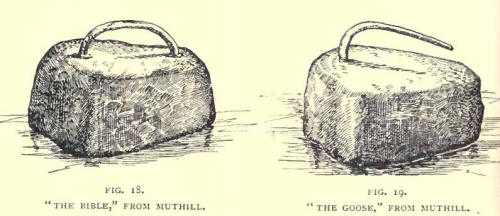
MARKINCH.—Old stone (in possession of the
Matron, John Balfour of Balbirnie) which has for more than a century borne
the name of "The Doctor," of the same shape as an old triangular smoothing
iron, with a well-fastened old iron handle. The stone is about 60 lbs.
weight. NEWTYLE.—One
old specimen is still preserved—a natural quartz boulder of unshapely build,
with an iron handle inserted, and weighing about 70 lbs. Smaller boulders
with three finger holes were once on the pond, entitled "The Goose" and "The
Gander," but they have both flown away. Other old stones were known as "The
Prince" and "The Kebbuck."
PITFOUR.—Within the last few years stones have
been found in this district doing duty in keeping tIle thatch on the roofs
of houses and hay-ricks, and supposed to be at least 150 years old. They are
rough and round or oval in shape, weighing from 20 to 30 lbs., with a piece
of rusty iron sunk into the top for a handle. They are evidently water-worn
and picked up from the sea-shore, or the bed of the nearest river. Colonel
Ferguson of Pitfour has two pairs of such stones.
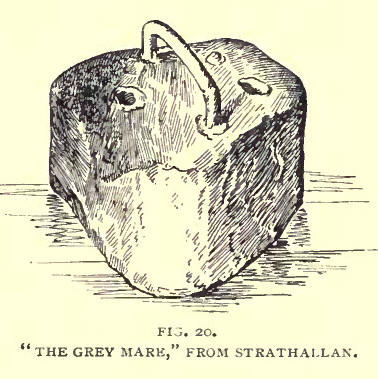 STRATHALLAN
MEATH MOSS.—Several old stones with iron handles, very rough, and with no
trace of work on them. One very old (Fig. 2 0) called "The Grey Mare," used
to be set on the table at curling dinners. The stone is just as it would be
when taken from the channel of the river. It has a handle inserted in it,
but from the holes that are also found pierced on its upper side it is
supposed by its owners to have been played once upon a time without a
handle. If this be so (but the size of the stone makes us doubtful) it is
interesting as shewing the transformation from the first to the second type
of stone. [Since this notice was in type we have received information from
the secretary of this club (R. Maxtone) of the discovery of a stone of the
earliest type by James Brydie, Hillhead, on the site of an old curling pond.
The stone weighs 23 lbs., and is an admirable specimen of the "loofie
channel-stane."] STRATHALLAN
MEATH MOSS.—Several old stones with iron handles, very rough, and with no
trace of work on them. One very old (Fig. 2 0) called "The Grey Mare," used
to be set on the table at curling dinners. The stone is just as it would be
when taken from the channel of the river. It has a handle inserted in it,
but from the holes that are also found pierced on its upper side it is
supposed by its owners to have been played once upon a time without a
handle. If this be so (but the size of the stone makes us doubtful) it is
interesting as shewing the transformation from the first to the second type
of stone. [Since this notice was in type we have received information from
the secretary of this club (R. Maxtone) of the discovery of a stone of the
earliest type by James Brydie, Hillhead, on the site of an old curling pond.
The stone weighs 23 lbs., and is an admirable specimen of the "loofie
channel-stane."]
TWEEDSMUIR.—One ancient specimen, shaped somewhat like a Tam o' Shanter
bonnet, is in possession of a member of this club. It was found in the
bottom of a deep pool in the Tweed, near Crook Inn.
TYNRON.—The curling-stone which belonged to John
M'Call, farmer, Glenmanna, Penpont, can be seen in Dr Grierson's Museum,
Thornhill (parish of Morton), where there is a. famous collection of
antiquities. It is a ponderous block weighing some 75 lbs. This John M'Call
was a very powerful man. Many stories are told of great feats of strength
performed by him. He "flourished" about 100 years ago.
[From the following Clubs we have also been
favoured with notices regarding old stones either in their possession, or in
the neighbourhood. They do not all refer us back to the time under
consideration, but they supply information that certainly links the present
with the past in an interesting way. The clubs are given in alphabetical
order :—Achalader (Airth, Bruce Castle, and Dunmore), (Antrum, Alevater and
Mounteviot), Ballingry, Balmerino, Belfast, Breadalbane (2 clubs), Bridge of
Allan, Cardross and Kepp, Castlecary Castle, Ceres, Croy, Cupar-Fife,
Dirleton, Doune, Dumfries, Dunglas and Cockburnspath, Eaglesham, Earlston,
Forrestfield, Fort-Augustus, (reenlaw, Hamilton, Hercules, Inverness,
Kinnochtry, Kinross, Kirknewton, Lees and Lithtillunm, Lillieslcaf,
Lochwinnoch, Logiealmond, Manchester Bellevue, _Meg,'inch, Melville, Methven,
Minnigaff, Montreal, Newport, Orwell, Penning'flamc, Pitlessic, Reston,
Roslin, Scotscraig, Shettleston, Spean, Stoneycreek, Stow, Strathkinnes,
Tinwald, Trinity Gask, Woodside (North), Upper Kithsdale.]
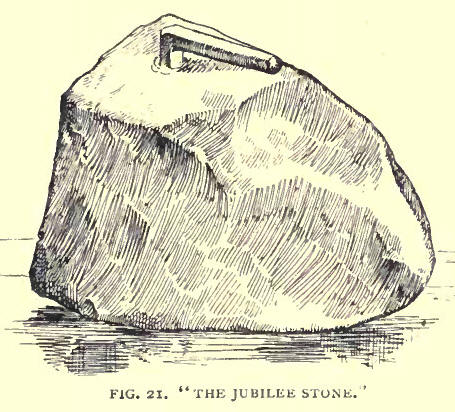 We
have kept to the end of the list "the king o' a' the core,"—the "last but
not the least:" the greatest in fact, of all that mighty race. In the
circumstances in which he has made his appearance he claims a special title
underneath his portrait, and we have therefore called him "The Jubilee
Stone." This extraordinary stone that now beats the record formerly field by
"The Saut Backet " of Coupar-Angus, was presented to the Popil. Caledonian
Club by John Wilson, Chapel-lull, Cockburnspath, and exhibited on its
arrival, at the Jubilee meeting of the club, held on the 25th July 1888; and
its portly presence also graced the banquet on November 28th. It weighs 117
lbs., and belonged to John Hood, a keen curler of that district, who died at
Townhead in January 1888. Mr Hood, it appears, had often seen his father
play the stone, and lie himself had played it occasionally before dressed
stones were introduced. It was sent by Mr Wilson to be preserved in the
archives of the Royal Club ; and we are sure that future generations of
curlers will look upon it with interest and astonishment, if not with
dismay. We
have kept to the end of the list "the king o' a' the core,"—the "last but
not the least:" the greatest in fact, of all that mighty race. In the
circumstances in which he has made his appearance he claims a special title
underneath his portrait, and we have therefore called him "The Jubilee
Stone." This extraordinary stone that now beats the record formerly field by
"The Saut Backet " of Coupar-Angus, was presented to the Popil. Caledonian
Club by John Wilson, Chapel-lull, Cockburnspath, and exhibited on its
arrival, at the Jubilee meeting of the club, held on the 25th July 1888; and
its portly presence also graced the banquet on November 28th. It weighs 117
lbs., and belonged to John Hood, a keen curler of that district, who died at
Townhead in January 1888. Mr Hood, it appears, had often seen his father
play the stone, and lie himself had played it occasionally before dressed
stones were introduced. It was sent by Mr Wilson to be preserved in the
archives of the Royal Club ; and we are sure that future generations of
curlers will look upon it with interest and astonishment, if not with
dismay. Such, then, are
the memorial stones of the giant age of curling. Varied is their destiny
from the ignominious lot of the poor outcast that acts as a foot-scraper in
the parish of the first historian of the game, to that of "the doctor,"
snugly ensconced in the patron's private parlour at Markinch, or, higher
than all, of the great monarch who presides at our banquets, and then sits
in state at the secretary's office to receive the admiring homage of his
subjects, who hail from every frosty clinic to pay respect to His Majesty.
They are indeed a "core" of matchless weight and power. In measuring against
them our modern capabilities, we ought, no doubt, to bear in mind that the
rink in those days was in all likelihood much shorter than it is now and
each pIayer used only one stone—the number of players on each side being
usually eight; but, even with such differences taken into account, we must
own that these big blocks alarm us with the conviction that the dissipation
of energy is going on more rapidly than natural philosophers seem to think.
Few of us would care to have
our life depending on the chance of sending the Jubilee stone "owvre a'
ice." 'Tak in by the handle" would be the cry that sealed our doom; but the
Titan of Cockburnspath thought nothing of the burden as he enjoyed the play;
and, if these weighty stones could speak, they would doubtless relate how
sweetly they were swung by the arms of their owners, and how gently they
were carried to and from the loch—very often in the cosy corner of the
shepherd's plaid. We have no reason to suppose that Cairnie's heroes,
William Gourlay and Aleck Cook were mythical—though we "sing small" as
William plays his 72-pounder, which takes off the guard full, moves on, and
in its progress raises half-a-dozen stones in succession, and gains the shot
that was declared to be impregnable. They cannot do that nor can we rival
Aleck the "ambidexter," who swung his long arm "so high, with the
curling-stone behind him, that, when about to raise the double guards, a
person standing on the tee opposite could see its entire bottom:" We listen
and believe (?) all that Broun tells us about the irate CIapperton, who
"seized the Lochmaben 'lien' with an arm of triumph, and whirled her
repeatedly round his head, with as much ease, apparently, as if she had been
nearer seven than seventy pounds; and when he relates how the president, in
reply to Laurie Young, the strongest player in Tinwald, who had challenged
the Lochmaben party to a trial of arm, stepped out, took his stone and threw
it with such strength across the breadth of the Mill Loch (nearly a mile),
that it stotted off the brink upon the other side, and tumbled over upon the
grass, adding thereafter—"Now, sir, go and throw it back again, and we'll
then confess that you are too many for us."
"There were giants in those days." We had better
just allow at once that the former days of curling "were better than these,"
in the physical force line. Herein just lies the difference between the
ancient and the modern game. As we engage in it now, we do so that we may
improve our physical as well as our mental and spiritual condition; but,
with the beautiful implements now in our hands, we have something else to do
than to shake a display of force. In curling, as in other accomplishments-
"It is well to have a giant's strength,
But tyrannous to use it like a giant."
To "draw," and "wick," and "creep through the
port," and "curl round the guard to the winner;" to "elbow in," and "elbow
out," and, in a hundred other ways, to temper force with discretion and
"canniness"—to reduce stone-throwing to one of the fine arts—this is the
modern curler's ambition, and, in as far as he succeeds, he advances beyond
the possibilities of ancient curling. It can easily be understood that, with
these coarse three-neukit stones, the niceties of the modern game were out
of the question: they played—they had to play, a striking game, and
stone-breaking was heroic at a time when stones cost nothing, but had simply
to be lifted of the nearest dyke or out of the nearest burn. It is not
surprising, therefore; to find that thunder is predominant in any
descriptions we have of the middle age of curling. One or two of these are
found heading this chapter. Mr Muir's picture recalls a style of play that
must have been on the wane when he sung his spirited song to the Duddingston
Club:- "A stalwart chiel,
to redd the ice,
Drives roaring down like thunder
Wi' awfu' crash the double guards
At ance are burst asunder
Rip-raping on frae random wicks,
The winner gets a yether;
Then round the tee we flock wi glee
In cauld, cauld, frosty weather."
As a Yankee would say, "I guess they found some
road metal beside that tee."
When Davidson (1789) describes the great contest
which took place at Carlingwark, between Ben o' Tudor and Glenbuck (Gordon
of Kenmure) in the olden time we "hear afar" the noise of rattling shots and
reckless shooters:- The
stares wi' muckle martial din,
Rebounding frae ilk shore:
Now thick, thick, thick, each other chased
An' up the rink did roar.
They closed fast on every side,
A port could scarce be found
An' many a broken channel-stane
Lay scattered up an' down.
Shew me the winner, cried Glenbuck,
An' a' behind stan' off:
Then rattled up the roaring crag
An ran the port wi' life."
Rough as the ancient game might be, it was,
however, on such a granite foundation that the sociality and brotherhood of
curling meetings were built up. The pillars of the bonspeil, "rivalry and
good fellowship," were then laid strong and deep—never to e shaken.
Thus did Bentudor and Glenbuck
Their culling contest end;
They met baith merry i' the morn,
At night they parted friends."
And thus did other contests begin and end. Then,
as now, the motto was, "meet friends and part friends;" and in their hard
fighting our forefathers did no forget what we try to remember, that, on the
icy plain, courtesy is due as much to those who vanquish us as to those who
are vanquished by us.
"In those days," says Mr Wilson in sending the Jubilee stone, and referring
to the time when such toys were used by his own and John Hood's ancestors,
"the gude-wife of the farmer used herself to carry to the pond luncheon in
the shape of a 'bicker of prose' made with the 'broo' of the beef and greens
being prepared for dinner, and all the players sat around and partook of
this substantial fare, washed down, we may safely assume, by a little of the
national beverage. After play was over they adjourned to discuss the said
beef and greens, and to 'fight their battles o'er again' over unlimited
tumblers of toddy." We have not, with all our advancement, beaten that
record of simple, homely, social enjoyment; the curling of the future never
will, for in such fellowship we "gie the grip " to a' keen curlers. The
manner of play—be it of the loofie days or the big boulder age, or of
some unimagined period which shall yet cast our own, with its boasted
perfection, into the shade, matters not: we are brithers a.', and the good
fellowship that binds its together in every age is stronger than the
developments that distinguish one age from another in the history of "our
ain game." THIRD TYPE:
THE CIRCULAR STONE.—The acquisition of a "handle" by the typical mortal to
whom reference has been made, with the consequent power and influence, does
not at first bring polish and refinement: the angles or corners have still
to be rubbed off; and this is the next stage of development entrusted to the
forces of civilisation, culture, and society. The evolution of the
curling-stone proceeds on similar lines. The squaring of the circle is
proverbially impossible, and the problem, happily, was not set before the
curler. His task was to make circular what was found square, oval, three-neukit,
hexagonal, or indescribable, as the case alight be; and it is evident, from
our illustrations, that he had every form and shape to work upon. Who first
accomplished this? For, was not the inventor of the circular stone the true
originator of curling? Did he not draw the game away, as we have said, from
its former modes and conditions so completely as to leave no connection,
except what can be recognised by the faculty that deals with the evidence of
what is not seen? The game of curling, in its origin, and in the incidents
of its progress, seems to be the work of some power other than human: it
comes as a gift from the unseen—keen curlers call it a divine gift; and, no
doubt, it is such if they use it aright, for it is the use of them that
makes all gifts divine or the opposite. The inventor of the circular
curling-stone, like the inventor of curling, is, and must remain, a "great
unknown." In our historical survey of the subject we content ourselves by
saying that the development was natural, and we wonder with those who wonder
that it did not come about sooner. We make a polite bow of thanks in name of
our countrymen to those writers (generally countrymen themselves) who argue
that the late appearance of the circular stone is an argument for the recent
origin of the game, on the ground that our intelligence would not have
allowed it to remain so long so imperfect.
["Had the game been of very ancient origin, we
should expect many of these improvements to have been made long before the
time when they actually were made. As society advances in improvement, arts
- and sciences advance at the same time. No human thing remains stationary.
If, then, we find curling-stones, at any period, in the rudest possible
form, having received no improvements, we have reason to conclude that the
origin of the game cannot be far distant from that period."—Duddingston
Account, etc., p. 17.
"That the game cannot boast of hoary antiquity is a conclusion which may
also be arrived at by a process of reasoning which dispenses with written
records, viz., from the rude shape and finish of curling-stones and handles
until within a very recent period. It is alleged that, in some instances,
within the memory of men still living, the stonesured merely a niche for the
finger and thumb to serve as a handle, and they were really `channel-stanes
' taken front the river or brook. The improvements in handles and stones
went on simultaneously at a rate, until a near approach to mathematical
precision was attained. Had curling been known in the Middle Ages these
improvements would doubtless have been effected sooner, for our noble
ecclesiastical piles and feudal strongholds bear ample testimony to the fact
that stone-masons, who usually mould and fashion curling-stones, were no
less accomplished tradesmen in mediaeval times than they are now. It may be
argued, however, that the blocks of which curling-stones are made are more
difficult to mould than stones hewn for cathedrals and fortresses. While
this is readily admitted, it is equally true that not one of the
curling-stones, even of so recent a date as the last century, possesses the
polish or finish usually met with in the ancient querns, or hand
mill-stones, which for many centuries were in universal use for grinding
corn, and which were often moulded out of solid whinstone."—J. B.
Greenshields, Annals of .Lesmaha flow (1864), p. 20.5.]
But the argument won't do. Old channel-stales,
like facts, "winna ding, and downa be disputed," and we have now got
evidence that they were in existence more than two centuries before the
rounding of the stone brought in the new era of curling, and the
intelligence of our countrymen was applied to the improvement of the stones.
The proof of antiquity assails the pride of intelligence. The compliment is
changed into a reflection, containing a rebuke. The bright palladium marked
"1511," which, as we have seen, guards us against a. foreign origin, within
a glass case at Stirling, becomes a bitter pill which (pace the Curator of
the Smith Institute) must be swallowed nolens volens; and we have simply to
confess that the lateness of the circular stone is a great discredit to
Scotland, and is unaccountable, except, perhaps, on the ground that our
forefathers found so much enjoyment in the imperfect game as to keep them
from thinking of improving upon it. Dr Samuel Johnson held that Scotland
consisted of two things—stone and water; and, as these are the primal
elements in the ancient game, he doubtless referred to this deficiency when
he remarked that, with all our learning and advantages, we were devoid of
elegance and embellishments till the Union! [He (Dr Johnson) owned the Scots
had been "a very learned nation for one hundred years—from 1550 to 1650, but
they afforded the only instance of a people among whom the arts of civil
life did not advance in proportion with learning: that they had hardly any
trade, any money, or any elegance before the Union: that it was strange
that, with all the advantages possessed by other nations, they had not any
of those conveniences and embellishments which are the fruit of industry,
till they came ill contact with a civilised people."—Boswell.] It is
interesting to notice that the visit of the grand old grumbler who did so
much to take the conceit out of us, was made about the time that curling set
out on its career of elegance and embellishment; and it would, perhaps, be
more correct to ascribe the improvement in curling to Dr Johnson's Tour to
the Hebrides in 1773, than to the Union. It is certain, indeed, that neither
had anything to do with the matter; and, as far as we can judge, the time of
the improvement is neither an argument for the recent origin of the game,
nor a reflection on the want of intelligence in those who played away so
long with loofie-stones, and sea, stream, or dyke boulders. Greater latent
possibilities than the circular channel-stane have lain for ages
undiscovered and undeveloped, and very often accident, or what is so-called,
only brought them to light. Then everybody wondered that they had never been
discovered or invented before—they were so simple. The greatest genius is he
who can write something, or invent something, so true to nature that
everybody admires its simplicity, and feels that it ought to have been done
long; ago, and that everybody might have done it.
Among the motley throng of boulders that
gathered within the brough as the ancient game went on, there were to
be found now and then stones worn quite circular, as we may find them yet by
the action of stream or sea—nature's productions. The players could not fail
to see a fitness about these that the others did not possess for dealing
with certain situations occurring in the struggle to lie nearest to the tee,
and out of this, doubtless, arose the idea of making all stones circular.
An outsider may have followed us till now
without being led to inquire as to the manner of playing the game and the
aim of the players, and we may take him so far into confidence at this stage
as to furnish him with the earliest description of the game—that of Pennant,
who made a tour in Scotland in 1772: - [A Tour in Scotland and Voyage to the
Hebrides, 1772. 2nd edition. Part I. page 93.]
"Of the sports of these parts," says Pennant,
"that of Curling is a favorite; and one unknown in England: it is an
amusement of the winter, and played on the ice, by sliding from one mark to
another great stones of forty to seventy pounds weight, of hemispherical
form, with an iron or wooden Handle at top. The object of the player is to
lay his stone as near to the mark as possible, to guard that of his partner,
which had been well laid before, or to strike off that of his antagonist."
There is little to add to this concise
description, except to say that in these times the rink or distance from
mark to mark (tee to tee), was generally no more than 30 yards; that the
player steadied himself in delivering his stone, and kept his footing on the
ice by means of cran pits (grippers, crisps), in appearance like
stirrup-irons, and fixed on his shoes .like skates, having prongs underneath
to grip the ice. In a contest there were then generally eight players on a
side, each playing one stone. With this preface we may introduce a plain
diagram (Fig. 22) to show the difficulty of skilful play with the ancient
stones, and the possibilities developed by the circular ones. It is not
certain that in these times the players were particular in playing over one
tee to the other, but, with their crampits on their shoes, they
would move off and make a flank attack when the enemy's front lines were
impregnable. This was, however, even in these times, bad form, and we may
suppose the player's stone to be coming in the direction of the arrow.
One circle or brough is drawn, of 8 feet in
diameter (the diameter in the early days ranged from 2 to 12 feet). In (1)
we have an oval stone, T, on the tee, guarded by an angular stone, A. These
are both the enemy's; and the player, with a three-neukit stone, is about to
play, his object being to remove the oval stone of the enemy from its
position on the tee. Touching the circle on the right of the triangular
stone or guard is the square stone B on his own side. What is he to do? How
will his three-neukit stone find the winner? The shot is no doubt a possible
one; it may even be demonstrated as such by mathematical science, or taken
in at a glance by a warlock like the renowned Tam Pate, who, with a three-neukit
stone, never missed a shot in the famous match of the Duke of Hamilton
against M`Dowall of Garthland in 1784. We venture to say, however, that in
an ordinary case the player would simply send up his stone and let it take
its chance, not knowing what it
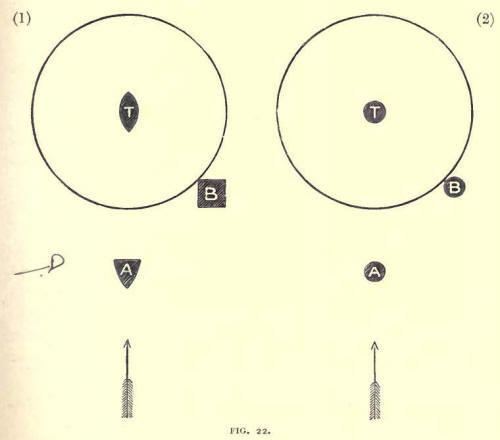
might do. In (2), with the same object in view,
the stones in their corresponding positions being circular, and the stone
which the player is about to play being also circular, it is at once evident
that he can find the winner on the tee, and displace it in several ways. The
proverbial three courses, at least, are open—to curl past the guard with the
Fenwick twist (of which more under "The Art of Curling"), and change places
quietly with the winner; to cannon or wick on the inner side of B, and at an
angle do the same thing; or to wick B on the outer side, and force it to
displace the winning-stone, and rest itself on the tee, which wouId be
equally successful, since B is on the player's side. In the position of this
game it will be noticed that only three have played out of the sixteen which
were generally found in conflict—eight against eight, in ancient times ; but
as the number of stones within the circle increases in (1), the difficulty
of skilful play will increase, and force and chance will more and more rule
the destinies of the fighters while in (2), though force will at times be
needed to clear complications, and chance continue to give its spice of
interest to the game, the player of skill will more and more be required for
the kittle shot, and the last of all will most likely require to be the most
skilful. Now there may
be a dubious precision in the situation of affairs thus sketched, for it is
not likely that the variegated implements would ever fall into position
exactly as above described; but it is enough if we have illustrated the
nature of the change brought about in curling by the circular shape of the
stones. It was a complete revolution in the game that was thus quietly
effected, and by it the game was elevated into a position of national
importance. It was thereby brought to a condition of perfection, such as to
entitle it to be transferred as a winter game to every corner of the world,
where the need of such amusement is felt. It was, without doubt, the most
far-reaching event in the history of curling. We have given the Kuting-stone
type, 1500-1650, and the boulder block, 1650-1800. And for practical
purposes this holds as correct, but we shall find the great change working a
good many years before the beginning of this century, when the boulder was
in disgrace and doomed to extinction, or to the (perhaps) less enviable fate
of being placed in an Antiquarian Museum as a relic of the olden time. The
old block had lived a hard life, and it died hard, as if struggling to the
last to avoid being left on the hard line of history. It took, from 50 to 80
years to die---an unconscionably long time to be moribund, a respectable
life-time in itself.
"Old Bonaparte," says Sir R. Broun, (Memorabilia, p. 42.) "who flourished
cir. 1750 and downwards, was the first who had a regular formed polished
Curling-stone upon our ice."
We do not hear of any earlier; while specimens
linger on upon the field of battle—antiquated and doomed--till the formation
of the Grand Club in 1838. It may be said, however, as marking the
transition, that, at the beginning of the last quarter of the eighteenth
century, the circular stones were novel lies, and by the end of the first
quarter of this century the boulder-stones were antiquities on the ice.
Cairnie says: "About
the year 1770, in many parts of Scotland, where the game is now almost
brought to perfection, the curling-stones were in their natural state as
taken from the fields, or from the beds of rivers, many of them in use
wanting handles, some of them having merely a hole made for the thumb, and a
few only having the benefit of a polished bottom: at that time too, the
stones were variously shaped, few of them so perfectly rounded as to be
admissible on the rink of 1833, and some of them of a triangular form, one
of which we ourselves well remember, 'ycelpt the cocked hat, truly
formidable on the ice: for, unless it was hit full, it often happened that
it was not moved far from the spot, but made the rotatory motion in great
perfection. At the present day, the shape of all curling-stones is, or
rather must be, circular; but in some places their shape, although circular,
is very uncouth; and we have a pair in our possession made at the Bridge of
Allan, that from their shape and handles are known by the name of the Water
Stoups. [Essay on Curling,]
Cairnie's correspondents at that time gave
similar testimony. Thus C. D., from Neilston:-
"Forty years ago the stones were generally
selected from dykes in the neighbourhood; but on one occasion a player
borrowed a shoemaker's lap or beating-stone, which gave him such an
advantage in playing that the others declined playing with him unless it was
laid aside." And A.
Crawford, Lochwinnoch:—
"Mr Cunningham of Craigends played in 1779 with
his grandfather's stone. His grandfather must have lived in the beginning of
the last century; the stage was natural, without polishing, except the plain
iron handle. It was three-neukit."
As an exquisite specimen of the roughness of the
old gauze, even under the auspices of a Laird, and of the reception the
new-fangled "circulars" got on their first appearance, we may give an
incident in the match played in 1783, between Beith and Lochwinnoch, the
latter club being; led as usual by Garthland mentioned above.
One Gavin Gibson, a Beith man, had a fine Osmund
Stone, and towards the gloaming it began to snow; Gibson let go his stone,
James Riddell sprung upon the cramps, followed the wake of Gavin's stone
through the snow and knocked it to flinders. Garthland hotched and leuch,
and held his sides, as Riddell expressed it."
So much for Gurthland, but the elegance and
embelishment of such horse-play have happily disappeared with the
Lochwinnoch boulders, and fine Ailsas are in no such danger as "fine
Osnnnnds" were on their first appearance in the time of Gavin Gibson and the
hotchin', lauchin' laird of Garthland. The circular stone, in its career,
has itself run into several types before I^econiing that " thing of beauty"
which makes it "a. joy for ever" in the hands of curlers. Our Kays and
Thorburns were not yet at work, and the mason and blacksmith were not up to
the art of polishing.
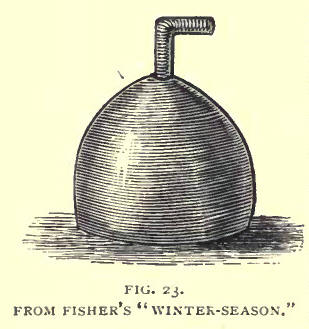 The
old boulders were not without a polish of a kind. Mr Wilson of Chapelhill
tells us that the old curlers, when they got a likely stone from the
sea-shore, dug a place for it in the stable entry, and after the horses'
hoofs had polished the stone sufficiently, they took it out to do duty on
the ice. Not more brilliant was the polish of the circular stone in its
early days. Its advantage lay simply in its rought circularity. For a long
time it remained one-sided. Pennant speaks of the stone that came under his
notice in 1772 as hemi-spherical, but one of the earliest developments was
the conical stone, .as we find it in one of the earliest illustrations we
have of the game a woodcut in the Winter-Season of James Fisher, the Blind
Fiddler of Ochiltree—(pub. 1810). The stone (Fig. 23), though circular, very
much resembles in appearance an ordinary mason's mallet. [In this connection
it is interesting to add the experience of John Pearson, now a builder in
Sheffield, which shows the true spirit of a curler, and the possibility of a
good game out of the ordinary mason's mallet—" In the winter of 1844-45 a
number of Scotch masons were engaged, along with others, in the erection of
Worsley Hall, the seat of the Earl of Ellesmere, near Manchester. The winter
being severe, and all work at a standstill owing to the frost, it became
difficult to know how to pass the time. There happened to be a good pond in
front of the Hall, on which we slided and skated until we got tired. At last
some one proposed that we should try Curling, but the question arose, How
could we get curling-stones? My father suggested that we should try 'our
mallets;. No sooner said than done. The ice was swept, the rink marked out,
and each selected a pair of mallets and commenced play. I can assure you
they made a very good substitute, the games being as keenly contested as if
we had been playing with the best Crawfordjohns or Burnocks. We were never
afterwards at a loss to know how to pass the time, and many of us, indeed,
were sorry when the frost went, and we had to give up our play. I have
played in many games, both in Scotland and in England, since then, but never
enjoyed Curling more than I did with the ordinary mason's mallet on the pond
at Worsley. The names of the players who took part in the games, as far as I
can remember, were D. Readdie, P. Whitten, R. Kirk, J. Burt, my father and
myself, from Kinross; H. Russel, Kettle; J. Clark, Colinsburgh; John Hare, a
member of a well-known family of curlers, from Sanquhar; W. Blake and J.
Scott, Durnfries; and J. Tait, Jedburgh. My uncle, then superintendent of
Worsley Yard for the Bridgewater Trust, joined us occasionally, John Hare
and my father generally acting as skips.] The
old boulders were not without a polish of a kind. Mr Wilson of Chapelhill
tells us that the old curlers, when they got a likely stone from the
sea-shore, dug a place for it in the stable entry, and after the horses'
hoofs had polished the stone sufficiently, they took it out to do duty on
the ice. Not more brilliant was the polish of the circular stone in its
early days. Its advantage lay simply in its rought circularity. For a long
time it remained one-sided. Pennant speaks of the stone that came under his
notice in 1772 as hemi-spherical, but one of the earliest developments was
the conical stone, .as we find it in one of the earliest illustrations we
have of the game a woodcut in the Winter-Season of James Fisher, the Blind
Fiddler of Ochiltree—(pub. 1810). The stone (Fig. 23), though circular, very
much resembles in appearance an ordinary mason's mallet. [In this connection
it is interesting to add the experience of John Pearson, now a builder in
Sheffield, which shows the true spirit of a curler, and the possibility of a
good game out of the ordinary mason's mallet—" In the winter of 1844-45 a
number of Scotch masons were engaged, along with others, in the erection of
Worsley Hall, the seat of the Earl of Ellesmere, near Manchester. The winter
being severe, and all work at a standstill owing to the frost, it became
difficult to know how to pass the time. There happened to be a good pond in
front of the Hall, on which we slided and skated until we got tired. At last
some one proposed that we should try Curling, but the question arose, How
could we get curling-stones? My father suggested that we should try 'our
mallets;. No sooner said than done. The ice was swept, the rink marked out,
and each selected a pair of mallets and commenced play. I can assure you
they made a very good substitute, the games being as keenly contested as if
we had been playing with the best Crawfordjohns or Burnocks. We were never
afterwards at a loss to know how to pass the time, and many of us, indeed,
were sorry when the frost went, and we had to give up our play. I have
played in many games, both in Scotland and in England, since then, but never
enjoyed Curling more than I did with the ordinary mason's mallet on the pond
at Worsley. The names of the players who took part in the games, as far as I
can remember, were D. Readdie, P. Whitten, R. Kirk, J. Burt, my father and
myself, from Kinross; H. Russel, Kettle; J. Clark, Colinsburgh; John Hare, a
member of a well-known family of curlers, from Sanquhar; W. Blake and J.
Scott, Durnfries; and J. Tait, Jedburgh. My uncle, then superintendent of
Worsley Yard for the Bridgewater Trust, joined us occasionally, John Hare
and my father generally acting as skips.]
Even as late as 1830, according to Sir R. Broun:—
[Memorabilia Curliana, p. 46.
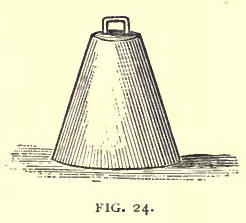 "Conical
shaped stones, i.e., stones made like a sugar-loaf, broad below and tapering
up, prevail at Dunblane: they are," he says, "very secure runners, and have
handles let into the stone at both ends, so that in delivery it is swung off
the fingers. They are also of great height, so as to prevent the player
stooping when throwing them. They are certainly more fanciful than elegant." "Conical
shaped stones, i.e., stones made like a sugar-loaf, broad below and tapering
up, prevail at Dunblane: they are," he says, "very secure runners, and have
handles let into the stone at both ends, so that in delivery it is swung off
the fingers. They are also of great height, so as to prevent the player
stooping when throwing them. They are certainly more fanciful than elegant."
Extremes meet—anal we find some again flattened
down like flukes, and between the two a great variety of high types of
stone, some of which are still popular with modern players.

A tendency to favour weight was still to be
found for a long time after the round stone was introduced. Pennant, we have
seen, puts the limit at 70 lbs. as far as his observation -went, but a good
many were above that weight. We have no "Jubilee Stones," "Saut Backets," or
"Sows," no circulars that balance a boll of meal, but we have many beyond
the "comprehension" of the modern curler among the relics of the early
circular age. William Gourlay, in the end of the century had a pair weighing
70 lbs. each, which he played—as we have seen—to great purpose, on the
Drumlie meadow, near Denny.
"Till lately" (1830), says a celebrated curler
of the Duddingston Society-,* "the stone which I played was 72½ lbs.—the
stone of my might!" A
Kilmarnock authority + says:-
"For forehand playing some have heavy stones. We
know of one pair as heavy as 75 lbs. each. In some of the neighbouring
parishes few stones are used lighter than 53, and many are of 60 lbs."
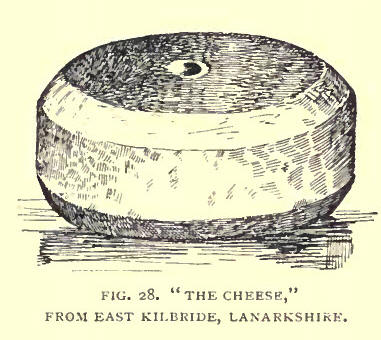 With
the circular stone the necessity of illustration: even of the very earliest
specimens is done away; and "The Cheese" (Fig. 28) here presented, may
simply stand for all its neighbours—only it has its history, and acquires a
certain importance from having been present with the curlers at their
Banquet in commemoration of the Royal Club's Jubilee. With
the circular stone the necessity of illustration: even of the very earliest
specimens is done away; and "The Cheese" (Fig. 28) here presented, may
simply stand for all its neighbours—only it has its history, and acquires a
certain importance from having been present with the curlers at their
Banquet in commemoration of the Royal Club's Jubilee.
"The Cheese" was one of a rink of stones made
about sixty years ago from a block of whinstone out of Thornton Hall quarry
in the parish of East Kilbride, Lanarkshire. It weighs 70 lbs., and was
played for a considerable time by Mr James Smith, then of Thornton Hall. The
last parish match at which it was played was about forty-five years .ago
(1843), when Mr James Strang of the Peel, Busby, played it as first stone
for the Carmunnock Club against the Mearns Club, Renfrewshire, on the
Brother Loch. On that occasion Mr Strang was the only curler on the ice who
could play "The Cheese" to the tee. On many occasions after matches it was
used as a test of strength, and at certain times of the year it was used for
the purpose of weighing oatmeal and cheese.
This is one immediate result of the circular
development —the individuality of the stones dies away just as we lose the
character of the old days—the bedesman, the packman, the daft Davie, through
the civilising work of "Puffing Billie." Stones, like human beings, are so
far monotonised by being civilised—they all become "cheeses." In some .cases
a certain distinction attaches to the stones as memorials of their owners,
as in the case of two still preserved in Penicuick House, which were played
by Sir James Clerk in the latter half of the last century, the one having a
Star (Fig. 29), and the other the family Horn ("Free for a blast") (Fig.
30), hewn out in the upper side.
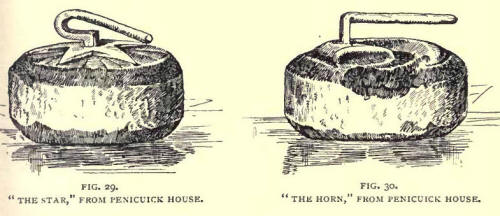
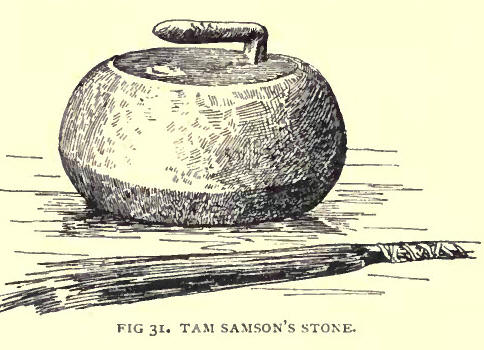 In
the keeping of the Ardgowan Club is one of the stones (Fig. 31) said to have
been played by " the king o' a' the core"--Tam Samson, immortalised by
Burns; and it is interesting—not only as a memorial of the curling "king,"
but as a good example of the earlier type of the circular stone. The stone
is only used in the initiation of members. It has a silver plate fixed into
it, with the inscription, "Tam Samson's Stane. Presented by Peter Morrison
to Ardgowan Curling Club, 1857." Its weight is 54½ lbs., circumference 35
3/4 inches, height 6 1/8 inches. Handle of iron--clear of stone 1 inch,
extreme height 1 3/4 inches. In
the keeping of the Ardgowan Club is one of the stones (Fig. 31) said to have
been played by " the king o' a' the core"--Tam Samson, immortalised by
Burns; and it is interesting—not only as a memorial of the curling "king,"
but as a good example of the earlier type of the circular stone. The stone
is only used in the initiation of members. It has a silver plate fixed into
it, with the inscription, "Tam Samson's Stane. Presented by Peter Morrison
to Ardgowan Curling Club, 1857." Its weight is 54½ lbs., circumference 35
3/4 inches, height 6 1/8 inches. Handle of iron--clear of stone 1 inch,
extreme height 1 3/4 inches.
An interesting set of stones (Fig. 32), with a
certain remnant of individuality about them, is that here represented by the
kindness of their possessor, J. Al. Thomson, Vice-President of the Holyrood
Club. From the situation in which they were discovered it is more than
likely that they belonged to the old Canonmills Club, and probably they are
as ancient specimens of the round stone as are anywhere to be found. One is
specially noticeable as having a ring handle; by which it was swung on the
first middle finger. They are marked by quaint lettering, typical of old
Scots figures.
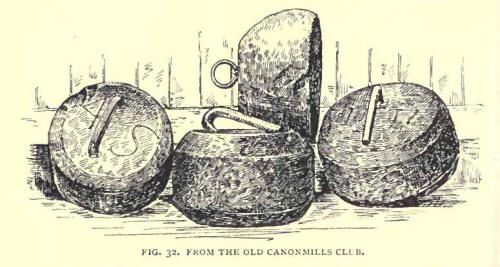
Cairnie tried to preserve the individual
nomenclature with his stock of stones which he provided for his little club
but there is nothing in the names—they are all of the bums a non lucendo
description, and he might as well have numbered them 1, 2, 3, &c. In 1820,
some years after a club had been formed at Largs, one bold member challenges
all his fellows-- "I,
with the Driver and John Bull,
The Glasgow and far-famed Secunder,
With Caledonia and Belle Poulle,
Shall beat the Club, or shall knock under.
And just that we may wet our throttle,
I'll lay of rum a single bottle."
The challenge from Parnassus was reducible
thus—"I, with six stones, will play any member of the club for a bottle of
rum." Cairnie's own attempt at immortalising the stock of "circulars"
provided for his friends is just as meaningless, but it is interesting as
the final attempt of this keenest of curlers to preserve the individuality
of the channel-stane.
LOQUITUR RECTOR.
No party politics around our Tee,
For Whig and Tory on the ice agree
Glory we play for, may it be our lot,
To gain the Bonsl)iel by a single shot.
Nises, we trust, will do as he is bid,
And young Euryalus oft lie patlid,
Guarded by Venus, he will rest secure,
And, Mars behind them, close the barrier door;
The Rose and Thistle vis-a-vis shall be,
To ward off wickers that would reach the Tee;
To break their line our Nelson cannot fail,
Napoleon's there, have at them in detail;
La Liberte triumphantly shall ride,
Conserro and Reform keep near her side;
Largs, as a player, doubtless will excel,
To move their winner we have William Tell;
Of marksmen good we many have to spare,
And Robin Hood and Little John are there
The game shall end before that it is late;
The winning stone, he shall be named Tam Pate.
In friendship we shall pass a jovial night,
And fix the day we may renew the fight."
A glance at this set of stones from Cairnie's
own Essay (Plate II.), will illustrate the loss of individuality in the new
curling era, and, at the same time, the enormous change for good that had
come about by roundness and polish at the end of the first quarter of this
century. These bring us, in fact, to the modern stone and the modern game.
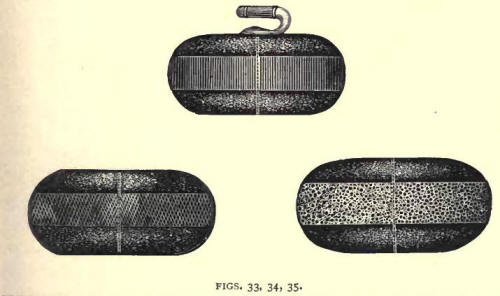
Our Study of Stones has we hope, given such
information as may be useful and interesting alike to the historian and the
curler. It will be noticed that we have counted of great importance the
introduction of the circular stone. If it be held to be discreditable to our
country that curling existed, as we have shown it must have clone, in some
form or other for upwards of two centuries before our ancestors thought of
using round stones, it ought, on the other hand, to be acknowledged that as
long as curling remained in its imperfect form, it never attained to the
rank of a national game—obscurity was the consequence of imperfect
development. But when, in addition to its being a game of chance and a test
of strength, it became a social force, bringing genial fellowship and kindly
intercourse between man and man as its results, and when it finally
developed, through the round weapon, into something that required scientific
skill on the part of those who engaged in it—then it rushed forward into
nationality, and, ever since, it has been recognised as the most truly
national of our amusements. The discredit of delay is surely atoned for by
the readiness with which it was adopted and cherished when it became worthy
of such treatment. In all national games it will be found that these
elements—chance, force, fellowship, and skill, have their place in greater
or less degree. It is so in football, cricket, golf, and other really
national games and we hope never to be found depreciating any of them that
we may glorify Scotland's ain game of curling. In none of them, however,
will the necessary elements of a truly national and popular amusement be
found more harmomously blended. From the special danger of them all—viz., to
develop scientific skill at the expense of all other things—we are protected
by the weather, which is the all-potent regulator of the conditions of our
game. At the same time our skill, in comparison with that of our ancestors,
ought to be infinitely superior with the improvements we have inherited.
Their force, their enthusiasm, as they battled long ago on the arena of the
icy plain, were not wasted; their happy evenings over "beef and greens," and
a tumbler or two afterwards, were not mere selfish indulgences, but their
play and their brotherly fellowship made them better men, and that
betterness is our inheritance to-day. No man lives to play—not even to
curl—keen, keen though he be ; but the man who knows how to temper duty with
pleasure, and feels that his amusements, as truly as his serious
employments, are worthy of attention, will best discharge what he owes to
those who lived before him, and to those who are to come after him.
"Thae wild days are gane, but their memories
call us,
So we'll stand by langsyne, and the guid ancient use."
It is our duty, as it is our, privilege, to
guard the honour, to increase the glory, to deepen the enthusiasm of curling
it is our inheritance—handed down for improvement while we have the use of
it, and to be handed on with added interest and value to those who succeed
us. "Let ilka true-born
Scottish son,
When cranreuch deeds the snawy
Brun', 'Mang curling cores seek harmless fun,
And gar his heart's blude tingle."
NOTE.—While these sheets were passing through
the press, two stones (Figs. 35 and 37) were sent to us by the kindness of
Mr A. Gow, having been found on the Fala Estate by him in 1835, and are now
in the possession of Lord Stair at Oxenfoord Castle. A number of others of
the same period have also been found on this estate.
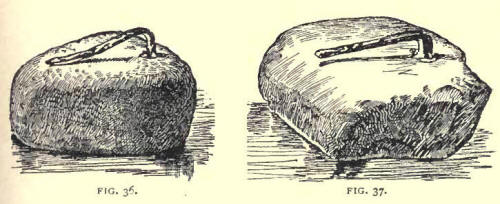 |

